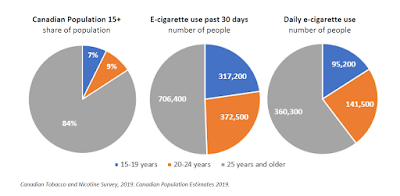It came after a long drought. Monitoring of e-cigarette use became a casualty of the restructuring of Health Canada's national drug use surveillance, last conducted in 2017. Both cannabis and e-cigarettes were legalized in the same year, but only cannabis received intensified surveillance. No federal agency was asking Canadians about their e-cigarette use for 23 months - including the first 17 months after the products began appearing in convenience stores.
Some of the survey results were posted at 8:30 this morning in Statistics Canada's The Daily. Information on the prevalence of use, the perceptions of harm and the reasons for using these products were made public. Not yet available are detailed tables, or information on how the use of these products is related to cigarette smoking behaviour.
Survey methodologists might cringe at comparing today's results with those done with a previous survey instrument, but such concerns may need to take a back seat as we try to grapple with what we are facing not quite 2 years after the nicotine market was so radically changed.
The law may have been intended to help adult smokers, but it is kids who have been mostly affected.
Among surveyed Canadians under 25 years of age, the proportion who have used e-cigarettes in the past month has grown almost 3-fold, from 6% to 15%. Yet among adult Canadians (over 25+). the change is so modest that further analysis may be required to establish whether it is statistically significant.
 |
| Graph prepared by Physicians for a Smoke-Free Canada |
Half of Canadian vapers are young people.
The limited information on today's release (which did not provide population estimates) requires other population estimates to be used to establish how many of Canada's vapers are youthful. Such ball-park estimates show that roughly half of those who have vaped in the past month are under 25, with a quarter under 19 years of age. About 4 in 10 daily vapers are under 25 - more than double their share of the overall population.
These numbers are staggering: more than quarter of a million underaged children are using e-cigarettes recently - and almost 100,000 on a daily basis.
 |
| Graph prepared by Physicians for a Smoke-Free Canada |
It's not harm reduction but drug effect and marketing that is driving youth use
Statistics Canada made available today the results of the questions on why people tried vaping. Just over one-third of all vapers identified reducing smoking as the main reason they vaped. The drug effects (enjoyment, reduce stress) and curiosity were most often cited by young people.
 |
| Chart prepared by Statistics Canada |
What we still don't know
The Canadian Tobacco and Nicotine Survey also asked Canadians detailed questions about their smoking behaviour, about their cannabis and alcohol use and about their quitting attempts. Sadly, none of these important factors were referred to in today's release.
Important too is to understand when vaping is related to nicotine or cannabis use. Today it was reported that about 9 in 10 young people used nicotine when vaping, but other studies suggest that children who self-report e-cigarette use are often confused or fail to recognize when they are consuming nicotine.
Hopefully more than could fit into today's 800 word government summary will soon be made available.
